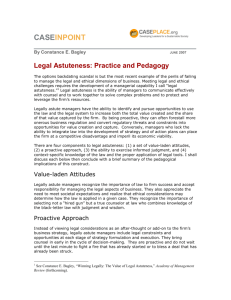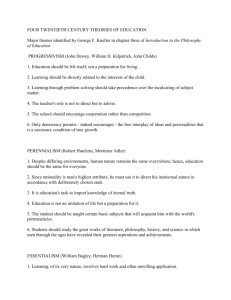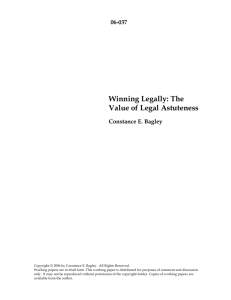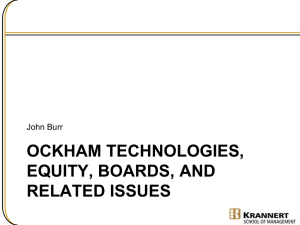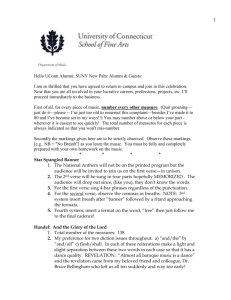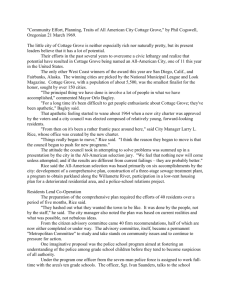In-house counsel_commodity derivatives
advertisement
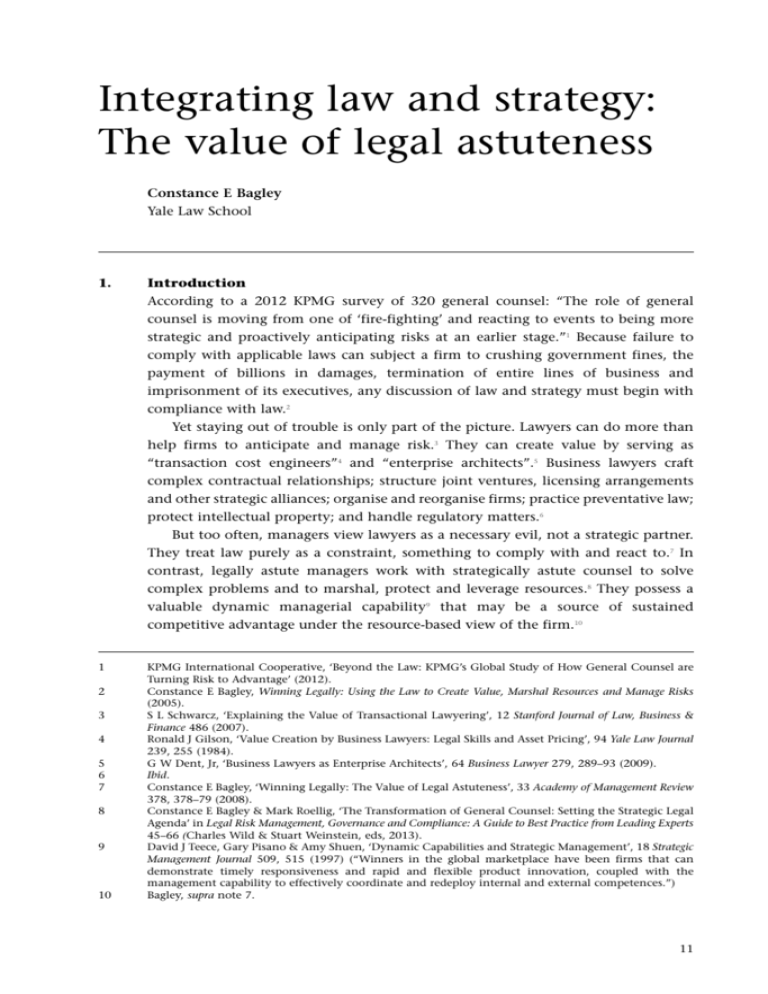
Integrating law and strategy: The value of legal astuteness Constance E Bagley Yale Law School 1. Introduction According to a 2012 KPMG survey of 320 general counsel: “The role of general counsel is moving from one of ‘fire-fighting’ and reacting to events to being more strategic and proactively anticipating risks at an earlier stage.”1 Because failure to comply with applicable laws can subject a firm to crushing government fines, the payment of billions in damages, termination of entire lines of business and imprisonment of its executives, any discussion of law and strategy must begin with compliance with law.2 Yet staying out of trouble is only part of the picture. Lawyers can do more than help firms to anticipate and manage risk.3 They can create value by serving as “transaction cost engineers”4 and “enterprise architects”.5 Business lawyers craft complex contractual relationships; structure joint ventures, licensing arrangements and other strategic alliances; organise and reorganise firms; practice preventative law; protect intellectual property; and handle regulatory matters.6 But too often, managers view lawyers as a necessary evil, not a strategic partner. They treat law purely as a constraint, something to comply with and react to.7 In contrast, legally astute managers work with strategically astute counsel to solve complex problems and to marshal, protect and leverage resources.8 They possess a valuable dynamic managerial capability9 that may be a source of sustained competitive advantage under the resource-based view of the firm.10 1 KPMG International Cooperative, ‘Beyond the Law: KPMG’s Global Study of How General Counsel are Turning Risk to Advantage’ (2012). Constance E Bagley, Winning Legally: Using the Law to Create Value, Marshal Resources and Manage Risks (2005). S L Schwarcz, ‘Explaining the Value of Transactional Lawyering’, 12 Stanford Journal of Law, Business & Finance 486 (2007). Ronald J Gilson, ‘Value Creation by Business Lawyers: Legal Skills and Asset Pricing’, 94 Yale Law Journal 239, 255 (1984). G W Dent, Jr, ‘Business Lawyers as Enterprise Architects’, 64 Business Lawyer 279, 289–93 (2009). Ibid. Constance E Bagley, ‘Winning Legally: The Value of Legal Astuteness’, 33 Academy of Management Review 378, 378–79 (2008). Constance E Bagley & Mark Roellig, ‘The Transformation of General Counsel: Setting the Strategic Legal Agenda’ in Legal Risk Management, Governance and Compliance: A Guide to Best Practice from Leading Experts 45–66 (Charles Wild & Stuart Weinstein, eds, 2013). David J Teece, Gary Pisano & Amy Shuen, ‘Dynamic Capabilities and Strategic Management’, 18 Strategic Management Journal 509, 515 (1997) (“Winners in the global marketplace have been firms that can demonstrate timely responsiveness and rapid and flexible product innovation, coupled with the management capability to effectively coordinate and redeploy internal and external competences.”) Bagley, supra note 7. 2 3 4 5 6 7 8 9 10 11 Integrating law and strategy: The value of legal astuteness The resource-based view posits that “a firm develops competitive advantage by not only acquiring, but also developing, combining and effectively deploying its physical, human, and organisational resources in ways that add unique value and are difficult for competitors to imitate.”11 Like failure to implement the correct corporate governance practices,12 failure to implement appropriate legal measures can prevent firms from fully realising the benefits of the other resources they control.13 While recognising that “competitive advantage can flow at a point in time from the ownership of scarce but relevant and difficult-to-imitate assets, especially knowhow”, Teece made it clear that “in fast-moving business environments open to global competition, and characterized by dispersion in the geographical and organizational sources of innovation and manufacturing, sustainable advantage… requires unique and difficult-to-replicate dynamic capabilities.”14 Teece divides dynamic capabilities “into the capacity (1) to sense and shape opportunities and threats, (2) to seize opportunities, and (3) to maintain competitiveness through enhancing, combining, protecting, and, when necessary, reconfiguring the business enterprise’s intangible and tangible assets.”15 There are legal components of each.16 For example, because “the locus of world-class research/productive capability might lie external to the enterprise”, firms may need to outsource at least aspects of their research and development to compete effectively.17 Legally astute top management teams can use a variety of legal structures to engage in research and development activities with others, such as university and company researchers, licensors and joint venture partners.18 Similarly, social media offer powerful means for discerning, anticipating and exploring customer needs, but the collection and use of personal data require adherence with the applicable laws and regulations governing privacy protection, which are particularly strict in the European Union. Section 2 sets forth the five elements of the dynamic capability of legal astuteness. Section 3 explains how legally astute top management teams and their strategically astute lawyers create realisable value while managing the attendant risks by: 11 12 13 14 15 16 17 18 12 Barry A Colbert, ‘The Complete Resource-Based View: Implications for Theory and Practice in Strategic Human Resource Management’, 29 Academy of Management Review 341, 343 (2004). See generally Jay B Barney, ‘Firm Resources and Sustained Competitive Advantage’, 17 Journal of Management 99, 106–11 (1991) (firm resources have the potential of providing sustained competitive advantage if they are valuable, rare, and imperfectly imitable by competitors, and have no strategically equivalent substitutes); Birger Wernerfelt, ‘A Resource-Based View of the Firm’, 5 Strategic Management Review 171 (1984). Jay B Barney et al, ‘The Resource Based View Ten Years After: Retrospective and Prospective’, 27 Journal of Management 625, 625 (2001). Bagley, supra note 7, at 385. David J Teece, ‘Explicating Dynamic Capabilities: The Nature and Microfoundations of (Sustainable) Enterprise Performance’, 28 Strategic Management Journal 1319, 1319 (2007). Ibid. See Constance E Bagley, ‘The Dynamic Capability of Legal Astuteness’ in Oxford Handbook of Dynamic Capabilities (David J Teece, ed, forthcoming). Teece, supra note 14, at 1331; Gary Pisano, W Shan & David J Teece, ‘Joint Ventures and Collaboration in the Biotechnology Industry’, in International Collaborative Ventures in US Manufacturing 183, 202 (D Mowery ed, 1998). Constance E Bagley & Christina D Tvarno, ‘Promoting “Academic Entrepreneurship” in Europe and the United States: Creating an Intellectual Property Regime to Facilitate the Efficient Transfer of Knowledge from the Lab to the Patient’, Duke Journal of Comparative & International Law (forthcoming); Constance E Bagley & Christina D Tvarno, ‘Pharmaceutical Public-Private Partnerships in the United States and Europe: Moving from the Bench to the Bedside’, 4 Harvard Business Law Review 301 (2014). Constance E Bagley • • • • • using formal contracts as complements to relational governance; protecting, redeploying and enhancing the value of knowledge assets and other firm resources; using legal tools to create valuable options and to combat risk/loss aversion and overconfidence bias; practising “strategic compliance management”19 and thereby converting regulatory constraints into opportunities; and helping shape the “rules of the game”20 governing business. Section 4 explains that there are degrees of legal astuteness; Section 5 concludes with the systems approach to law and strategy, a descriptive integrating framework for understanding law and strategy. 2. Elements of legal astuteness Legal astuteness requires: • a set of value-laden attitudes about the importance of law and ethical behaviour to firm success; • a proactive approach to management, regulation and risk; • the ability to exercise informed judgement when managing the legal and business aspects of business; • context-specific knowledge of the law and the appropriate use of legal tools;21 and • strategically astute lawyers.22 2.1 Value-laden attitudes Legally astute top management teams understand that “business decisions consist of continuous, interrelated economic and moral components.”23 When dealing with conflict, business leaders and their counsel “should keep trying to reframe issues and refine tactics until they are satisfied that the firm’s legitimate business objective of ‘winning’ in the marketplace is being advanced in an effective, legal, and above board manner.”24 In short, they acknowledge that “the moral aspects of choice” are the “final component of strategy.”25 The general counsel “is sometimes viewed as the ‘ethics police person,’ who catches inappropriate activities and institutes corrective actions to bring the rulebreaker into compliance with corporate governance standards. The GC is [usually] also a key member of the committees that examine the adequacy of internal controls 19 20 Bagley, supra note 2, at 50. Douglass C North, Institutions, Institutional Change and Economic Performance (1990) (the “rules of the game” include both formal, explicit rules, such as constitutions, laws and property rights, as well as informal, often implicit rules, such as conventions, norms of behavior and codes of conduct). Bagley, supra note 7, at 379. Bagley & Roellig, supra note 8. D L Swanson, ‘Addressing a Theoretical Problem in Reorienting the Corporate Social Performance Model’, 20 Academy of Management Review 43, 51 (1995). Bagley & Roellig, supra note 8. Edmund P Learned, C Roland Christensen, Kenneth R Andrews & William D Guth, Business Policy: Texts and Cases 578 (1969). 21 22 23 24 25 13 Integrating law and strategy: The value of legal astuteness and compliance with regulatory rules.”26 Or, as Bond Pearce managing partner Victor Tettmar put it, general counsel should be the “guardian of moral capital.” Bagley27 and Bagley and Roellig28 assert that every manager has a responsibility to ensure ethical behaviour and compliance with law. “Creative compliance” – that is, “complying with the letter of the law but defeating its spirit and purpose”29 and taking advantage of unintended legal loopholes30 – can lead to ethical and unlawful behaviour down the road. Especially when discussing values, “management communicates as much by what it doesn’t do or say as by what it says and does. In fact, behavioral forms of communication are apt to have more credibility than spoken or written forms.”31 As Ben Heineman, former general counsel of General Electric, explained: “The stirring call for performance with integrity at the large company meeting can be eroded by the cynical comment an executive makes at a smaller meeting, by the winks and nods that implicitly sanction improprieties, by personal actions (dishonesty, lack of candor) that contradicts company values.”32 The ethical business leader’s decision tree (see Figure 1) is an example of a tool that legally astute managers can use to assess not only the legality but also the ethics of their proposed actions.33 Managers are encouraged to ask first whether the action complies with the letter and spirit of the law. If it does, then the next inquiry is whether it would enhance shareholder value. Even if it would not, legally astute managers will go on to ask whether it would be unethical to refrain from acting. This reflects not only the importance of meeting the manager’s and the firm’s ethical standards, but also the need to meet societal expectations, which directly affect a firm’s licence to operate, the application and interpretation of existing laws and regulations, and the adoption of new laws and regulations. If the management team elects to take an action that is not legally mandated and does not enhance shareholder value, then it should disclose the reasons behind its decision to shareholders so they can take them into account when casting their votes for the board of directors at the next election. This transparency prevents management from using its professed concern for other constituencies or broad societal welfare to mask poor performance.34 26 27 28 29 30 31 32 33 34 14 A D Jagolinzer, D F Larcker & D J Taylor, ‘Corporate Governance and the Information Content of Insider Trades’, 49(5) Journal of Accounting Research 1249, 1249 (2011). Bagley, supra note 7. Bagley & Roellig, supra note 8. Timothy P Terrell, ‘Professionalism on an International Scale: The Lex Mundi Project to Identify the Fundamental Shared Values of Law Practice’, 23 Emory International Law Review 469, 536 (2009) (defining “creative compliance” as “complying with the letter of the law but defeating its spirit and purpose”). Daniel T Ostas, ‘Legal Loopholes and Underenforced Laws: Examining the Ethical Dimensions of Corporate Legal Strategy’, 46 American Business Law Journal 487, 487 (2009) (noting that “using the law for private gain raises a number of potentially thorny ethical issues”). Philip P Drotning, ‘Organizing the Company for Social Action’, in The Unstable Ground: Corporate Social Policy in a Dynamic Society 260 (S Prakash Sethi ed, 1974). Ben W Heineman, Jr, ‘Avoiding Integrity Land Mines’, Harvard Business Review, April 2007, at 102. Constance E Bagley, ‘Forethought: The Ethical Leader’s Decision Tree’, Harvard Business Review, February 2003, at 18–19 (2003). Constance E Bagley & Karen Page, ‘The Devil Made Me Do It: Replacing Corporate Directors’ Veil of Secrecy with the Mantle of Stewardship’, 36 San Diego Law Review 897 (1999). Constance E Bagley Figure 1. The Ethical Business Leader’s Decision Tree Yes Yes Is it ethical? (To answer, weigh the effect on customers, employees, the community, the environment and suppliers against the benefit to shareholders) Does it maximise shareholder value? No Is the proposed action legal? No Would it be ethical not to take action? (To answer, weigh the harm or cost that would be imposed on the shareholders against the cost or benefits to other shareholders) No No Don’t do it Yes Do it Don’t do it Yes Don’t do it Do it but disclose the effect of the action to shareholders 2.2 Proactive approach Legally astute top management teams recognise that “[b]usiness corporations do not have legal problems. They have business problems where legal considerations may be more or less important, depending on the specific circumstances.”35 Taking a proactive approach fosters threat and opportunity identification, learning and experimentation, key processes in dynamic environments.36 For example, a proactive strategy for reducing pollution and addressing other environmental matters that “anticipate[s] future regulations and social trends and design[s] or alter[s] operations, processes, and products to prevent (rather than merely ameliorate) negative environmental impacts” is a dynamic capability that can offer competitive advantage.37 According to Nehrt, 35 36 37 Marshall Clinard & Peter C Yeager, Corporate Crime 20 (1980). Teece, Pisano, & Shuen, supra note 14; Teece, supra note 21. J Alberto Aragón-Correa & Sanjay Sharma, ‘A Contingent Resource-Based View of Proactive Corporate Environmental Strategy,’ 28 Academy of Management Review 71, 73 (2003). See also William Q Judge & Thomas J Douglas, ‘Performance Implications of Incorporating Natural Environmental Issues Into The Strategic Planning Process: An Empirical Assessment’, 20 Academy of Management Review 1015, 1015 (1998); Robert D Klassen & D Clay Whybark, ‘The Impact of Environmental Technologies on Manufacturing Performance’, 42 Academy of Management Review 599, 599 (1999). 15 Integrating law and strategy: The value of legal astuteness firms’ ability to reduce pollution became a source of competitive advantage only after firms replaced the mindset of reducing pollution to meet government end-of-pipe restrictions with a search for ways to use environmentally friendly policies to create value.38 General Electric’s ecomagination campaign, designed to promote the development and sale of energy-efficient products and to reduce its own emissions, reduced expenses by more than $100 million and increased the revenues generated by its environmentally friendly products, such as hybrid locomotives and more efficient jet engines.39 Proactive strategies for dealing with the interface between a firm’s business and the natural environment that went beyond environmental regulatory compliance were associated with improved financial performance.40 The continuum of approaches to managing the interface between business and the natural environment Aragon-Correa and Sharma describe – which ranges from a reactive posture that responds “to changes in environmental regulations and stakeholder pressures via defensive lobbying and investments in end-of-pipe pollution control measures” to proactive postures – can be extended to the interface between business and other aspects of the legal environment.41 Managers who view the law purely as a constraint, something to react to rather than to use proactively, will miss opportunities to use the law and legal tools to sense opportunities and threats, to seize opportunities, and to protect, marshal, leverage and redeploy tangible and intangible assets.42 As Siedel explained: “law plays an important role in both reducing costs and creating value for your customers – by enabling you to offer either lower prices or products that provide unique benefits.”43 He provided examples from lawsuits dealing with product liability, workers compensation, wrongful discharge, sexual harassment and environmental regulation to support this claim.44 Managers who fail to be proactive will also lose the benefits provided by strategically astute lawyers, who can help to drive business success.45 As Bagley and Roellig explain, “the later a lawyer is brought into the planning of a transaction, the more likely it is that the lawyer will have to say ‘no.’ Anticipating this, business managers may provide counsel with a skewed set of facts in hopes of improving the 38 39 40 41 42 43 44 45 16 Chad Nehrt, ‘Maintainability of First Mover Advantages When Environmental Regulations Differ Between Countries’, 23 Academy of Management Review 77, 77 (1998). Martin LaMonica, ‘Newsmaker: Stirring GE’s Ecomagination’, CNET News.com, Oct 26, 2007, http://news.cnet.com/Stirring-GEs-Ecomagination/2008-11392_3-6215496.html. William Q Judge & Thomas J Douglas, ‘Performance Implications of Incorporating Natural Environmental Issues Into The Strategic Planning Process: An Empirical Assessment’, 20 Academy of Management Review 1015, 1015 (1998); Robert D Klassen & D Clay Whybark, ‘The Impact of Environmental Technologies on Manufacturing Performance’, 42 Academy of Management Review 599, 599 (1999). Aragon-Correa & Sharma, supra note 37, at 73. Bagley, supra note 16. George J Siedel, Using the Law for Competitive Advantage 5 (2002). See also George J Siedel & Helena Haapio, ‘Using Proactive Law for Competitive Advantage’, 47 American Business Law Journal 641, 656-57 (2010) (drawing parallels between the US literature on using law for competitive advantage and the European Proactive Law Movement, which “‘[i]n addition to avoiding disputes, litigation and other hazards’… ‘seeks ways to use the law to create value, strengthen relationships and manage risk.’”) Bagley & Roellig, supra note 8. Constance E Bagley likelihood of receiving the go-ahead.”46 To avoid this dynamic and promote not only compliant corporate behaviour but also value creation and capture, general counsel should act as strategic partners and encourage managers to take an active role in legal matters from the outset – that is, to be legally astute.47 This is an extract from the chapter ‘Integrating law and strategy: The value of legal astuteness’ by Constance E Bagley in General Counsel in the 21st Century, Challenges and Opportunities, published by Globe Law and Business. Please go to www.GlobeLawandBusiness.com for further details of all titles. 46 47 Constance E Bagley & Mark Roellig, ‘General Counsel: Strategic Partners or Hired Guns?’ in European Company Lawyers Association, Company Lawyers: Independent by Design (2014). Bagley & Roellig, supra note 8. 17
